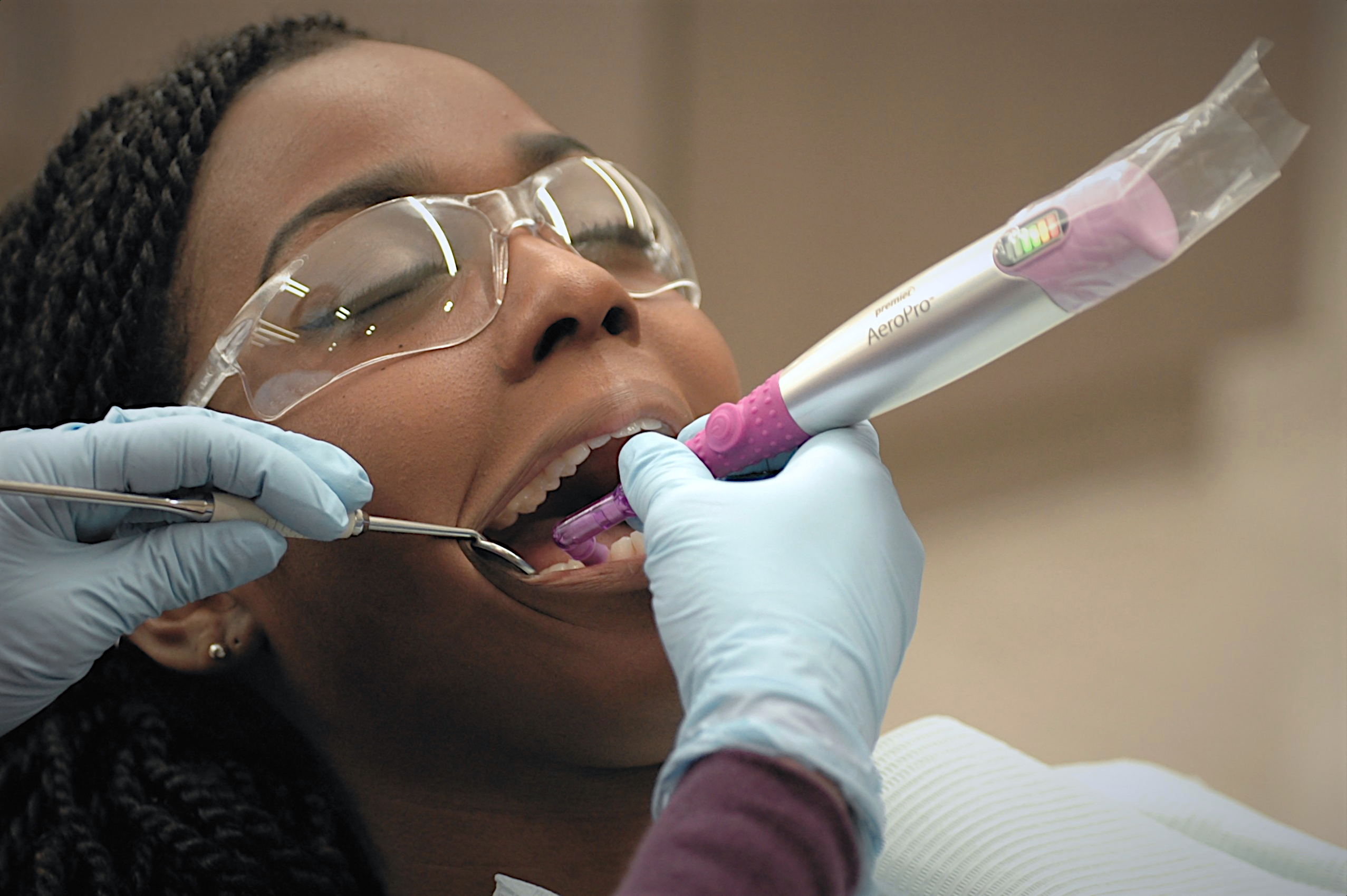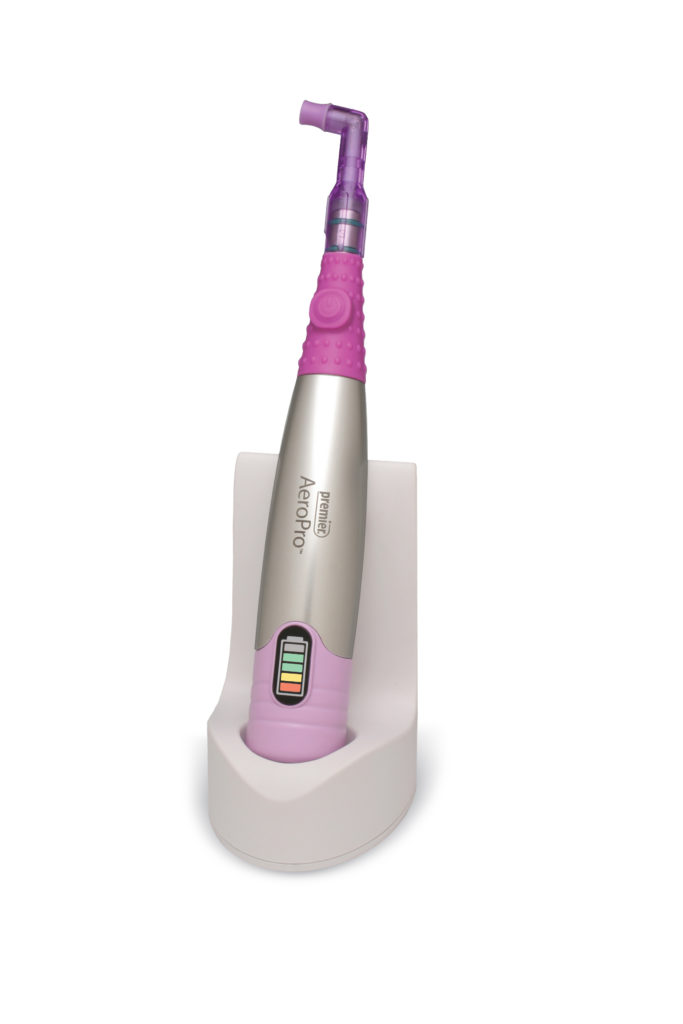The practice of dentistry by all members of the clinical team involves static posture, precise and repetitive motions, long work hours, and ergonomic challenges.

Figure 1: AeroPro™ Cordless Prophy Handpiece and 2pro® Disposable Prophy Angle (Premier Dental®) being used to complete a coronal polishing procedure.
These factors contribute to a prevalence of musculoskeletal disorders (MSDs) among dentists and dental hygienists ranging from 64-93%, with prolonged static postures and repetitive movements listed as the key risk factors.1,2 More concerning, dental hygienists seem to be at disproportionate risk for MSDs compared to dentists with a study showing 67% of dentists and 86% of dental hygienists reporting MSD pain.3 Focusing on hand and wrist pain, the same study reported a higher prevalence of hand pain in hygienists compared to dentists, 75% versus 38% respectively.

Figure 2: The components of the AeroPro™ Cordless Prophy Handpiece System (Premier Dental®). From left to right: 2pro® Disposable Prophy Angle, outer sheath, and disposable polyurethane barrier and motor component.
Technology has helped provide solutions for dental hygienists, specifically by the introduction of larger handled instruments and ultrasonic inserts which have more effective tips for better control and precision. However, prophy handpieces have historically been air-driven and decidedly unergonomic with tubing connected to a slow speed motor and straight nose cone. This delivery system can be heavy and create chronic fatigue to the upper extremities, hands, and wrists. More recently, cordless prophy handpieces have been introduced to further help dental hygienists combat hand and wrist stress and these benefits were confirmed in a study by McCombs and Russell.4 They compared the muscle loads required during simulated tooth polishing using a corded versus a cordless handpiece. Electromyography (EMG) was used to measure the activity of four muscles involved in high pinch force. The results showed a reduced EMG for three out of the four muscles tested when the cordless handpiece was used, and an average 30-second reduction in polishing time with the cordless handpiece. The dental hygienists preferred the cordless handpiece over the corded handpieces used in the study. When queried as to why, they listed – a lack of cord, less weight, better balance, and low noise – as the main reasons for the preference.
The results showed a reduced EMG for three out of the four muscles tested when the cordless handpiece was used, and an average 30-second reduction in polishing time with the cordless handpiece.
Based on extensive input from dental professionals, Premier Dental® recently introduced the AeroPro™ Cordless Prophy Handpiece System (Fig. 1-3). The AeroPro™ system was engineered to provide clinicians with greater mobility, choice, and control; further helping to prevent symptoms of hand and wrist fatigue and to provide a better polishing experience for both operator and patient.

Figure 3: AeroPro™ Cordless Prophy Handpiece System (Premier Dental®).
Compatible with most disposable prophy angles, AeroPro™ allows the angle to be easily rotated 360° for improved intraoral access. From Premier’s website, AeroPro™ is “ergonomic and lightweight with a well-balanced design, featuring a textured grip for reduced pinch strength and hand fatigue.” It is controlled using a single button, allowing the operator to easily access the most appropriate prophy cup speed for the procedure. AeroPro™’s speeds range from 500-2800 rpm.
AeroPro™ is equipped with ChargeSMART™ Battery Technology. This innovative induction charging system powers AeroPro’s battery quickly and safely and ensures a long-lasting charge that lasts through a busy workday.
And finally, AeroPro™ is CDC-compliant with a convenient infection prevention protocol. The motor component is isolated by a custom-fit disposable polyurethane barrier and covered by a durable, metal outer sheath. After use the metal sheath is removed, cleaned, and autoclaved, while the motor component is disinfected (Fig. 2).
Written by Jason H. Goodchild, DMD
Published in TIPS – May/June, 2019

Jason H. Goodchild, DMD
Jason H. Goodchild, DMD is the Director of Clinical Affairs, Premier Dental Products Company, Plymouth Meeting, Pennsylvania; an associate clinical professor, Department of Diagnostic Sciences, Creighton University School of Dentistry, Omaha, Nebraska; an adjunct assistant professor, Department of Diagnostic Sciences, Rutgers School of Dental Medicine, Newark, New Jersey; and in private practice in Havertown, Pennsylvania. He can be reached at: JGoodchild@PremUSA.com.
References:
- Hayes MJ, Cockrell D, Smith DR. A systematic review of musculoskeletal disorders among dental professionals. Int J Dent Hyg. 2009;3:159-65.
- Padhye NM, Padhye AM, Gupta HS. Effect of pre-procedural chair-side finger stretches on pinch strength amongst dental cohort – a biomechanical study. J Clin Diagn Res. 2017 Apr;11(4):ZC82-ZC85.
- Rucker LM, Sunell S. Ergonomic risk factors associated with clinical dentistry. Can Dent Assoc J. 2002;30(2):139-146.
- McCombs G, Russell DM. Comparison of corded and cordless handpieces on forearm muscle activity, procedure time and ease of use during simulated tooth polishing. J Dent Hyg. 2014;88(6):386-393.
Category: Merchandise
Back to Articles